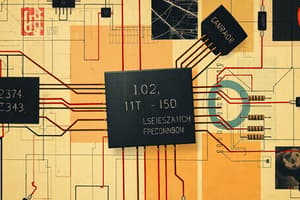Podcast
Questions and Answers
في какие vật liệu xảy raالتوصيل Electrical conduction بسبب حركة الأيونات؟
في какие vật liệu xảy raالتوصيل Electrical conduction بسبب حركة الأيونات؟
- مجσ導ات
- مجσ 半導ات
- فولاذ
- م vật liệu یونیک (correct)
ما هو النموذج الذي يبسّط سلوك الإلكترونات في الفولاذ؟
ما هو النموذج الذي يبسّط سلوك الإلكترونات في الفولاذ؟
- نظرية دي بريولي
- نظرية النطاق
- نموذج الإلكترون الحر (correct)
- نظرية شرودінгر
ما هو تأثير زيادة درجة الحرارة على التوصيل الكهربائي في الفولاذ؟
ما هو تأثير زيادة درجة الحرارة على التوصيل الكهربائي في الفولاذ؟
- ينقص التوصيل
- يتوقف التوصيل
- يزيد التوصيل (correct)
- يظل التوصيل كما هو
ما هو تأثير الدوبинг على التوصيل الكهربائي في المواد شبه الموصلة؟
ما هو تأثير الدوبинг على التوصيل الكهربائي في المواد شبه الموصلة؟
في أية الأنظمةsonoة التوصيل الكهربائي المواد شبه الموصلة używane؟
في أية الأنظمةsonoة التوصيل الكهربائي المواد شبه الموصلة używane؟
ما هو الهدف من نظرية النطاق؟
ما هو الهدف من نظرية النطاق؟
Flashcards are hidden until you start studying
Study Notes
Types of Electrical Conduction in Solids
- Metallic Conduction: Occurs in metals, where free electrons (also known as delocalized electrons) move freely, carrying electrical charge.
- Semiconductor Conduction: Occurs in semiconductors, where electrons are not entirely free, but can be excited to conduct electricity with the help of thermal or light energy.
- Ionic Conduction: Occurs in ionic solids, where ions move to conduct electricity.
Mechanisms of Electrical Conduction in Solids
- Band Theory: Explains conduction in solids based on the energy levels of electrons in a material. Valence band and conduction band are separated by an energy gap.
- Free Electron Model: Simplifies the behavior of electrons in metals, treating them as a gas of free electrons.
Factors Affecting Electrical Conduction in Solids
- Temperature: Increases in temperature can:
- Increase conduction in metals (as electrons gain kinetic energy)
- Increase conduction in semiconductors (as more electrons are excited to the conduction band)
- Decrease conduction in ionic solids (as ionic motion is hindered)
- Doping: Introducing impurities into semiconductors can:
- Increase conduction (p-type or n-type doping)
- Create regions with different electrical properties (p-n junctions)
Applications of Electrical Conduction in Solids
- Electronics: Diodes, transistors, and integrated circuits rely on semiconductor conduction.
- Electrical Power Distribution: Metallic conduction enables efficient transmission and distribution of electrical power.
- Energy Storage: Ionic conduction is crucial in batteries, where ions move between electrodes.
Studying That Suits You
Use AI to generate personalized quizzes and flashcards to suit your learning preferences.




